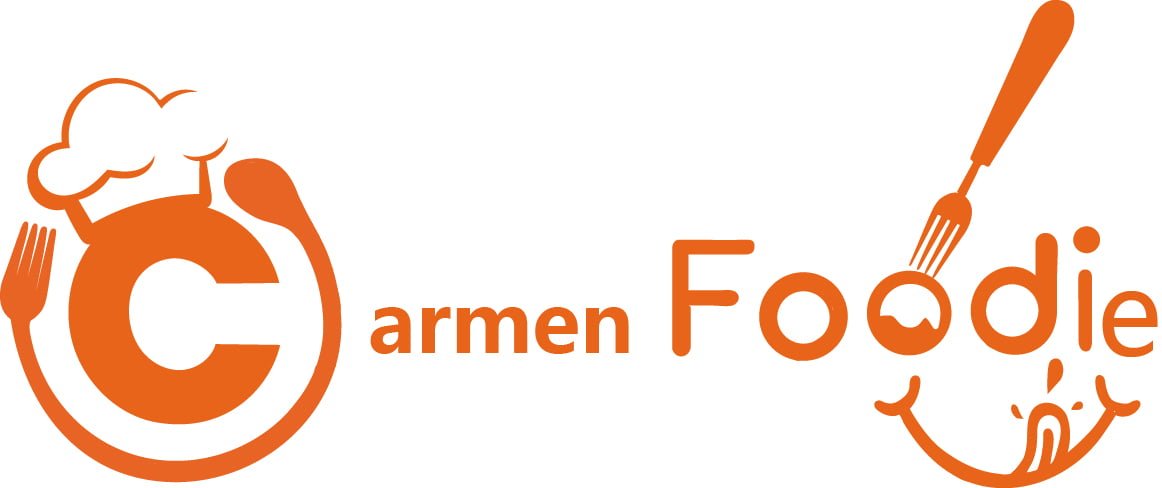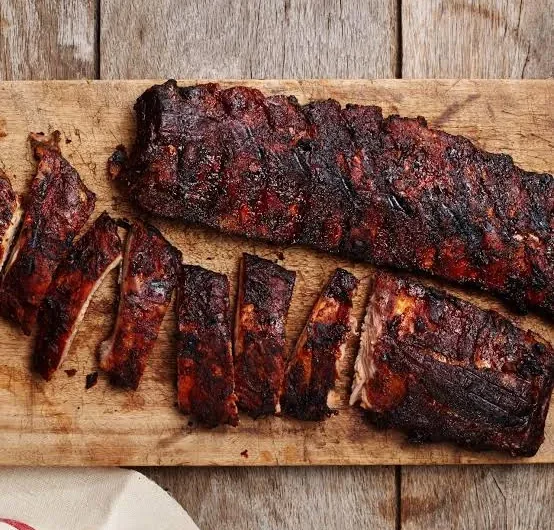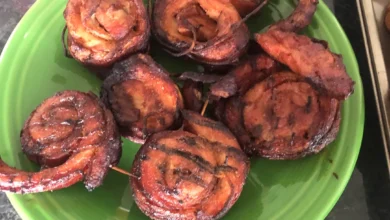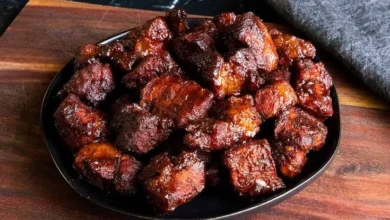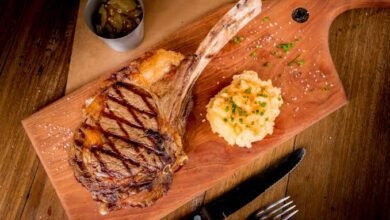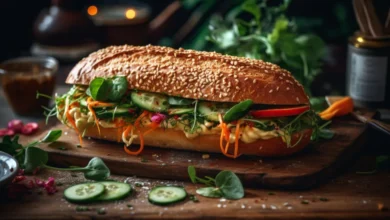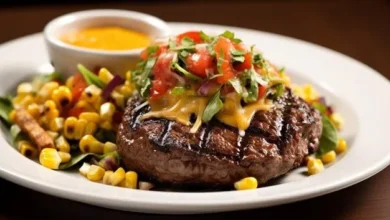The Best Smoked Baby Back Ribs You’ll Ever Have: Tender & Easy

Crack open a cold one, ’cause it’s finger-lickin’ good rib time! These babies are smokin’ hot (literally) and guaranteed to satisfy your inner caveman. Dive in, grab a rib, and brace yourself for a “Mmm, that’s good!” explosion!
Contents
- Smoked Baby Back Ribs
- What are Baby Back Ribs?
- What is the Difference between Baby Back Ribs and Pork Spare Ribs?
- What To Look For When Buying Baby Back Ribs?
- Prepping the Smoked Baby Back Ribs
- Get the Smoker Ready
- Smoking the Baby Back Ribs
- Alternate Method for Super Tender Smoked Baby Back Ribs (2-2-1)
- How Do You Keep Baby Back Ribs From Overcooking?
- How Do You Know When Baby Back Ribs Are Done Cooking?
- How To Make Baby Back Ribs in the Oven?
- Serving the Smoked Baby Back Ribs
- Expert Tips & Tricks
- Frequently Asked Questions (FAQs)
- How long does it take to smoke baby back ribs?
- Should I smoke these ribs at 225°F or 250°F?
- How long do you smoke baby back ribs at 225?
- What is the 3 2 1 rule for smoking ribs?
- Are baby back ribs smoked?
- What is the 2 1 1 method for baby back ribs?
- What is the best temp to smoke ribs?
- How to smoke the most tender baby back ribs?
- What temperature are smoked ribs done?
- What temperature do you wrap baby back ribs?
- Smoked Baby Back Ribs
Smoked Baby Back Ribs
Smoked baby back ribs are a sublime choice for any barbecue, with their tender meat infused with smokehouse flavors. Whether as a main course or appetizer, they are sure to satisfy every guest during the holidays or year-round celebrations.
What are Baby Back Ribs?
Baby back ribs, also known as pork ribs, are cut from the loin section of a pig, which is located directly between the spine and the loin. The loin contains some of the most tender pork on the animal, which is why baby back ribs are widely considered to be the most tender type of pork ribs. Baby back ribs typically include a small section of the rib bone with some meat still attached. Baby back ribs are usually best when roasted or smoked low and slow.


What is the Difference between Baby Back Ribs and Pork Spare Ribs?
Baby back ribs tend to be a smaller length than spare ribs, as they contain more tender meat on the front of the rib. This more tender meat allows baby back ribs to cook in less time compared to thicker spare ribs.
Baby back ribs and spare ribs come from different parts of a pig’s anatomy. Baby back ribs are the rib section that is closest to the spine. Spare ribs contain the rib section that is closest to the belly. The loin section, which produces baby back ribs, is a smaller section of ribs than the belly section. Since spare ribs come from the belly section, they tend to be longer in length than baby back ribs cut from the smaller loin section.
Baby Back Ribs Are More Tender Than Spare Ribs
The meat on baby back ribs is generally more tender than the meat on spare ribs. As baby backs come from the rib section closest to the pig’s spine, the muscles in this area are not used as much as other muscles when the pig moves around.
For the same reason, the loin meat that is closest to the spine tends to be more tender, since these muscles do not get exercised as much. This proximity to the spine is why baby back rib meat remains more tender and delicate compared to the meat on spare ribs.
Baby Back Ribs Cook Faster Than Spare Ribs
The meat on baby back ribs is more tender and the ribs themselves smaller compared to spare ribs. This is because the baby back rib meat is located closer to the pig’s spine. Due to the tender nature of the meat and size, baby back ribs can be cooked faster than spare ribs. While spare ribs risk drying out under quicker high heat cooking, the characteristics of baby back ribs make them more likely to retain moisture even at a slightly faster rate.
A usual oven temperature for baby back ribs of 375 degrees Fahrenheit works well due to their tender meat. Recipes often find this heat fully cooks the small, delicate baby back ribs within one hour. Spare ribs have meat not as near to tender. So they require the lower temperature of around 325 degrees or fewer to break down slowly to prevent drying out. This elongated cooking of two hours or more at a gentler heat ensures the meat tenderizes throughout.
Tip: Carmen Foodie recommends going low and slow — the relaxed environment grants wood-fired smoke extended time to thoroughly season the ribs.
Baby Back Ribs Are Usually Meatier Than Spare Ribs
Typically, baby back ribs include a modest section of tenderloin meat remaining atop the front of the rib bone after butchering. Spare ribs, however, undergo removal of any attached fat or pork belly pieces during processing. If more of the front region went uncut, only scraps of fat tissue would be present.
Consequently, baby back ribs regularly possess an extra morsel of succulent meat perched on top of the ribs, in addition to meat situated between each rib bone. In comparison, spare ribs have their meat mainly limited to the narrow spaces among the much longer rib bones, with no additional meat in other areas.
What To Look For When Buying Baby Back Ribs?
When buying baby back ribs at the store, carefully look at the individual cuts and choose those with noticeably more meat along the front of the ribs.
That additional meat is loin meat, which is exceptionally delicious and tender. For this exact reason, some butchers choose to leave just a small portion of meat at the front area of the rib, to retain more meat on the loin. Always get the plumpest cut available.
Prepping the Smoked Baby Back Ribs
Remove The Silver Membrane
Most ribs have a very thin, plastic-like covering on the boney side that can become quite unpleasantly chewy if left on during cooking. The first step I recommend doing at home to your pork ribs is to carefully remove the membrane.
For those new to rib preparation, removing the membrane can seem intimidating, but it’s actually not too difficult. Once the ribs are removed from their packaging, I lay them meat side down on a sturdy sheet pan or cutting board. From there, I can slide the handle of a spoon underneath the membrane to carefully pry it away from the bones. Or for an even easier method, use a paper towel gripped in your hand for leverage.
With a little care and patience, you’ll be removing the membrane in no time. Plus, it means your homemade barbecue will be that much more delicious and tender to enjoy! For these reasons, it’s usually worth taking the time to remove it.
Season The Ribs
I spread mustard on the bone side of the ribs, using it as a binder for the rub. Then, I generously cover the ribs with BBQ Rub, gently patting it down. Next, I flip the ribs and repeat the same step, so the seasoning should lightly cover the entire surface of the ribs but not to be caked on.


While just salt and pepper may be fine, I usually like to add excitement with a store-bought dry rub. Or you can make your own baby back rib rub from scratch, ribs take the variety of flavors to continually experiment with new flavor combinations that I like best.
Alternate Seasoning Options For Baby Back Ribs
One quick and easy way to initially season baby back ribs is by simply sprinkling your favorite spice rub. However, that is not the only way. You could also:
- Brine the ribs ahead of time for extra flavor and tenderness.
- Spread a thin layer of paste (like mustard) on the ribs before adding the dry seasoning to help it stick on.
- Apply an additional round of dry seasoning that happens towards the end of cooking or even post-grilling/smoking to let those flavors go later.
Get the Smoker Ready
Once the ribs are seasoned, it’s time to set up the smoker for slow cooking. Aim to maintain a consistent temperature of around 250 degrees using the indirect heat method. If your smoker uses a water pan, be sure it is filled up before placing the grates in. Once fully preheated and ready to go, it’s then simply a matter of time until those ribs are cooked to fall-off-the-bone perfection!
Smoking the Baby Back Ribs
I start by placing the seasoned ribs on the top rack of the smoker. I close the lid and allow them to slowly cook uncovered for around an hour and a half. During this time, the outside of the ribs begins to form a delicious bark. After the initial cooking period, I start to regularly spritz the ribs with a Cherry Coke mixture every 30 minutes. They continue cooking indirectly for another hour and a half.
Once about 3 hours have passed, I carefully pull the ribs off the smoker grate. I then prepare a cozy bed of butter, brown sugar and honey between layers of heavy-duty foil. The ribs are gently placed meat side down onto the sweet topping. I securely wrap the packet tight and return it to the smoker for an additional hour. Keeping the temperature at around 250 degrees, the wrapped ribs become fall-off-the-bone tender during this time.
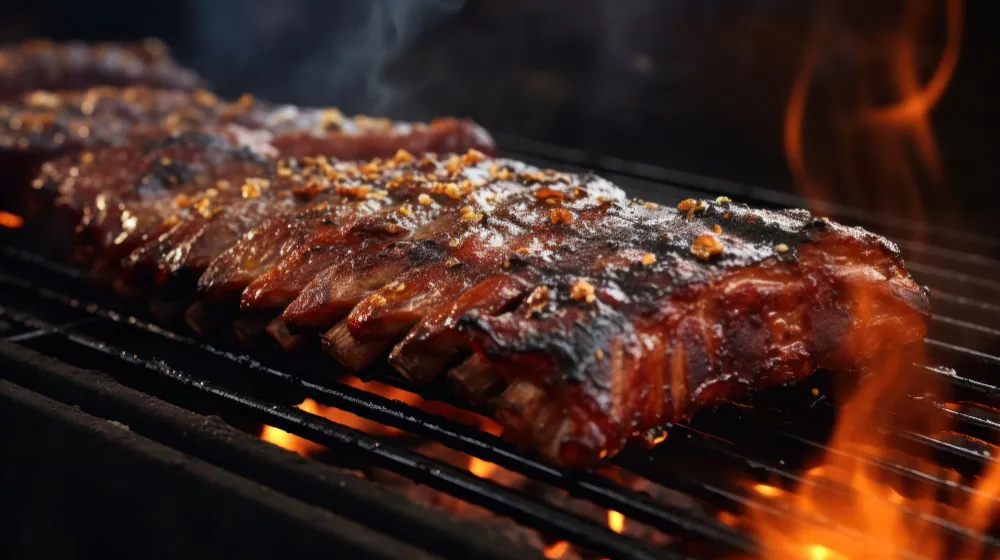

Finally, the delicious smoked ribs are ready to be sauced and crisped. I brush on a sticky BBQ sauce before giving them a final cook over indirect heat. The sauce is then nice and sticky to enjoy with the fall-off-the-bone ribs!
Alternate Method for Super Tender Smoked Baby Back Ribs (2-2-1)
- Place the seasoned ribs on the smoker grate and smoke for 2 hours at 225°F (107°C).
- At the 2-hour mark, wrap the baby ribs tightly in heavy-duty foil or place in a foil pan. Spritz the ribs with apple juice before closing or covering with foil.
- Continue cooking the ribs at 225°F for 2 hours in the wrapped configuration.
- At the 4-hour mark, remove the ribs from the foil and place back onto the grate. Continue cooking for an additional 1 hour to firm up the bark and finish them off. This is also a great time to sauce them how you like.
How Do You Keep Baby Back Ribs From Overcooking?
Baby back ribs are a forgiving cut of meat, but it’s still possible to overcook them if you’re not careful. Here are some tips to avoid overcooking the ribs:
- Take your time – Cook the ribs slowly at a low temperature, like 250°F. Rushing the process makes overcooking more likely.
- Use an instant-read meat thermometer to check for tenderness. Ribs are usually done between 195-205°F when cooked low-and-slow.
- Pay attention to visual cues like the formation of the delicious brown bark on the outside and moistness on the inside.
- Don’t be afraid to start checking ribs for done-ness after the minimum suggested cook time. Every grill is different.
With a little attention, it’s easy to make baby back ribs that are tender but not soggy by simply keeping an eye on things during the long, slow cooking process at a low temperature.
How Do You Know When Baby Back Ribs Are Done Cooking?
There are differing opinions on just how much to cook baby back ribs. Some people prefer the ribs to be fall-off-the-bone tender, while others prefer them to be just a little less cooked, so the meat has a subtle bite when you tug it away from the bone with your teeth. In reality, there is no “right” doneness—it comes down to personal preference! Here are some indicators that the ribs may be done:
- If cooking ribs to the fall-off-the-bone style, they’re typically done when the individual rib bones are easily separated by simply pulling the rack apart with your bare hands or fork.
- For those preferring ribs with a bit more bite, aim for the rib meat to be fork-tender —meaning a clean fork can easily pierce through any part of the rack without encountering resistance.
- While an instant-read thermometer can offer a ballpark temperature range, it’s not the best way to solely measure doneness on ribs. Unlike a steak or pork chop trimmed to the same thickness, each individual rib contains different thicknesses at different points along the rack. Therefore, the meat can be at different temperatures depending on whether an area is closer to or further away from the bone.
How To Make Baby Back Ribs in the Oven?
If you don’t have access to a smoker, it’s still possible to make delicious baby back ribs using just your oven. Begin by preheating the oven to 275°F. Generously massage your favorite dry rib rub into the meat.
Wrap each slab of ribs tightly in heavy-duty aluminum foil and bake for about 2 hours, flipping once halfway through. At the 2-hour mark, remove the ribs from the oven and open the aluminum foil.
Using a basting brush, baste the exposed ribs liberally with your preferred BBQ sauce. Set the oven setting to broil and broil for just 5 minutes to caramelize the sauce. Remove the ribs from the oven and let rest wrapped back up for 5–10 minutes before serving.
Serving the Smoked Baby Back Ribs
The smoked baby back ribs are sure to be a crowd-pleasing main dish fresh from the smoker. For cutting, I simply separate each rib at the joint lines to make easy-to-eat portions.


Pair the fall-off-the-bone ribs with classic sides like baked or smoked potatoes and smoked veggies. For the veggies, I keep the seasoning simple – just some olive oil, salt, pepper, garlic powder and paprika. Any vegetables like broccoli, peppers, red onion, zucchini, carrots are tossed and stirred well before being smoked until nice and tender.
RELATED: Smoked Queso Dip Recipe
RELATED: Smoked AU Gratin Potatoes
Expert Tips & Tricks
- Experiment with different BBQ rubs and BBQ sauces to find favorite flavor combinations.
- When it comes to purchasing meat for smoking baby back ribs, I personally prefer buying it from my local specialty butcher. However, I’ve also had success buying ribs from large retailers like Costco and Sam’s Club. Their consistent selection makes it easy to find what you need.
- Wood chips like Cherry Coke, root beer, Hickory, and apple or cherry wood all work well for smoking baby back ribs.
- For ribs cooked to be “fall off the bone”, wrap in heavy-duty foil for an additional 30 minutes to an hour.
- Ribs are perfectly done when the bones are loose, and they bend in a loose arch without the bark breaking.
- Low and slow is king – smoking at between 225-250°F for 4–5 hours should deliver tender results.
- Leftover ribs will keep for 3–4 days in the fridge if wrapped in foil or stored in an airtight container. Simply reheat in a 350°F oven for about 20 minutes until heated through.
Wrapping It Up
The Smoked Baby Back Ribs recipe delivers moist, tender ribs infused with smokehouse flavors through the low-and-slow cooking process. With practice of the smoking technique and attention to cooking times and temperatures, home cooks can enjoy fall-off-the-bone ribs with all the deep flavor of true barbecue. With some experimentation using different wood chips and seasonings, anyone can succeed in producing this classic smoked meat dish.
————————————
Frequently Asked Questions (FAQs)
How long does it take to smoke baby back ribs?
It typically takes 5–7 hours to properly smoke baby back ribs. The precise cook time varies depending on the smoking temperature and method used.
Should I smoke these ribs at 225°F or 250°F?
Most find 225°F produces more tender ribs, but both temperatures work well if cooking time is adjusted. 225°F creates a slower, low-and-slow cook.
How long do you smoke baby back ribs at 225?
Smoking baby back ribs at 225°F for 5–6 hours, checking for tenderness, provides deep smoke flavor and juicy meat falling off the bone.
What is the 3 2 1 rule for smoking ribs?
The 3-2-1 method involves smoking uncovered for 3 hours, wrapping for 2 hours, then unwrapping for 1 hour to glaze and set the sauce.
Are baby back ribs smoked?
Yes, smoking is a very common and favorite method for cooking baby back ribs to add rich smoky flavors throughout the tender meat.
What is the 2 1 1 method for baby back ribs?
The 2-1-1 method involves 2 hours uncovered, 1 hour wrapped, then 1 more uncovered to set the sauce. This style can make the ribs extra tender.
What is the best temp to smoke ribs?
Most pitmasters agree that 225°F is the best temperature for low-and-slow smoking ribs to achieve fall-off-the-bone tenderness without risk of drying out.
How to smoke the most tender baby back ribs?
Using the 3-2-1 or 2-1-1 wrapping methods paired with a 225°F temperature will reliably produce ribs that are tender enough to pull cleanly from the bone.
What temperature are smoked ribs done?
Smoked ribs are ready when they reach an internal temperature between 195-205°F and the meat is tender enough to easily tear or pull from the bone.
What temperature do you wrap baby back ribs?
The 221 or 321 smoking methods both involve wrapping the ribs after a certain period, typically around 160-170°F internal temperature, or when they have set a nice smoke ring color.
Smoked Baby Back Ribs
Course: Smoked CuisineCuisine: American4
servings15
minutes5
hours300
kcal5
hours15
minutesLow and slow smoking coaxes the richest flavors from baby back ribs. The tender, fall-off-the-bone meat is enhanced by wood smoke penetrating deep within each rib.
Ingredients
Baby Back Ribs
Yellow Mustard
BBQ Rub
BBQ Sauce
1 12 oz can Cherry Coke or Root beer
Pats of Butter
Brown sugar
Honey
Directions
- Remove The Silver Membrane
- Most ribs have a very thin, plastic-like covering on the boney side that can become quite unpleasantly chewy if left on during cooking. The first step is to carefully remove the membrane.
- For those new to rib preparation, removing the membrane can seem intimidating, but it’s actually not too difficult. Once the ribs are removed from their packaging, lay them meat side down on a sturdy sheet pan or cutting board. From there, you can slide the handle of a spoon underneath the membrane to carefully pry it away from the bones. Or for an even easier method, use a paper towel gripped in your hand for leverage.
- Season The Ribs
- Spread mustard on the bone side of the ribs, using it as a binder for the rub. Then, generously cover the ribs with favorite BBQ Rub, gently patting it down.
- Next, flip the ribs and repeat the same step, so the seasoning should lightly cover the entire surface of the ribs but not to be caked on.
- Get the Smoker Ready
- Once the ribs are seasoned, it’s time to set up the smoker for slow cooking. Aim to maintain a consistent temperature of around 250 degrees using the indirect heat method. If your smoker uses a water pan, be sure it is filled up before placing the grates in. Once fully preheated and ready to go, it’s then simply a matter of time until those ribs are cooked to fall-off-the-bone perfection!
- Smoking the Baby Back Ribs
- Start by placing the seasoned ribs on the top rack of the smoker. Close the lid and allow them to slowly cook uncovered for around an hour and a half. During this time, the outside of the ribs begins to form a delicious bark.
- After the initial cooking period, start to regularly spritz the ribs with a Cherry Coke mixture every 30 minutes. They continue cooking indirectly for another hour and a half.
- Once about 3 hours have passed, carefully pull the ribs off the smoker grate. Then prepare a cozy bed of butter, brown sugar and honey between layers of heavy-duty foil. The ribs are gently placed meat side down onto the sweet topping.
- Securely wrap the packet tight and return it to the smoker for an additional hour. Keeping the temperature at around 250 degrees, the wrapped ribs become fall-off-the-bone tender during this time.
- Finally, the delicious smoked ribs are ready to be sauced and crisped. Brush on a sticky BBQ sauce before giving them a final cook over indirect heat. The sauce is then nice and sticky to enjoy with the fall-off-the-bone ribs!
Notes
- One full rack of smoked baby back ribs will comfortably serve 2 average adult eaters.
- If you want ribs that are tender but do not fall off the bone, a good way to check the temperature is to probe only the meat between the bones, avoiding the bones themselves. “Competition style” ribs that are fall-off-the-bone tender are fully cooked and tender when they reach an internal temperature of 190°F/88°C.
- For best results, serve barbecue sauce on the side rather than basting the ribs as they cook. This allows people to control how much sauce they want.
